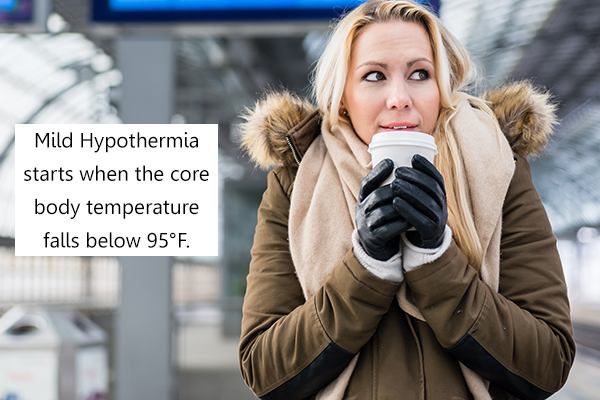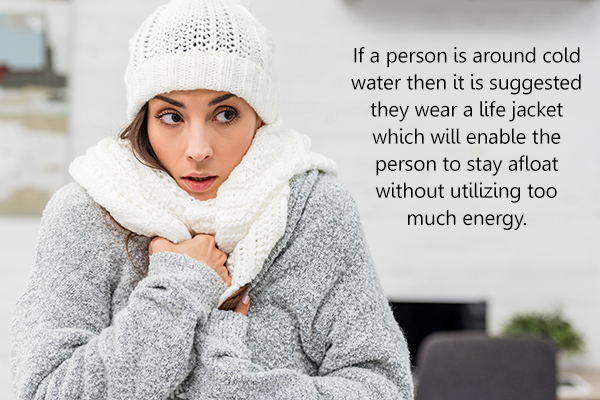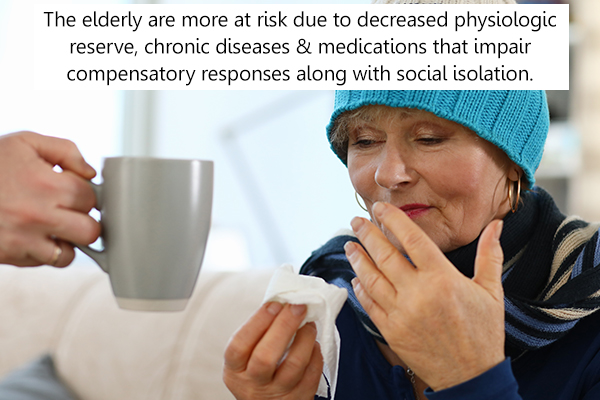In this article:
The normal body temperature of humans is 37°C (98.6°F) with half a degree Celsius variation in both directions. (1) However, due to extremely cold environmental conditions, the core body temperature may drop below 35°C (95°F). This condition of a low body temperature is medically known as hypothermia. (2)

Hypothermia is commonly seen in places with severe winters. However, hypothermia may also affect people living in milder climates, especially in summers, as people are unprepared for sudden temperature drops.
In the United States, hypothermia causes around 1,500 deaths annually. (3)
How the Body Loses Heat
The body typically generates heat in the muscle tissues to regulate body temperature. Heat production may increase due to exercise, shivering, or obesity.
Body heat is primarily lost through the skin, especially:
- When it is not covered by clothing
- On direct contact with cold objects
- In a cold environment
- When wearing wet clothes
Some amount of heat may also be lost through the lungs via respiration. The rates of heat loss from the body depend on the body mass index, body surface area, presence of subcutaneous adipose tissue, and various other conditions of heat loss.
Stages and Symptoms of Hypothermia

Hypothermia is classified into three stages.
1. Mild hypothermia
Mild hypothermia is a condition wherein body temperatures reach 95 °F and below. It manifests the following symptoms:
- Shivering
- Feeling cold
- Increased heart rate
- Elevated blood pressure
- Increased breathing rate
2. Moderate hypothermia
Moderate hypothermia refers to body temperatures below 89.6°F. This is characterized by the following symptoms:
- Amnesia
- Confusion
- Slower reflexes
- Slurred speech
- Decreased motor skills
- Increased breathing rate
- Elevated heart rate
- Reduced cardiac output
- Shivering (which is noneffective)
3. Severe hypothermia
Severe hypothermia is characterized by body temperatures falling below 82.4°F. At this stage, physiological systems start declining, including lowering of blood pressure, heart rate, and respiratory rate and absence of shivering.
In some cases, people may start removing their clothes as they reach severe hypothermia. This is known as paradoxical undressing and occurs due to confusion and loss of rational thinking.
Treating Hypothermia
Hypothermia management involves the following aspects:
1. Prevention of further heat loss
This includes evaluating and treating the breathing, blood circulation, and airway support.
2. Rewarming the body
The body needs to be brought to normal temperatures according to the degree of hypothermia.
- For mild hypothermia, passive external rewarming is practiced wherein the patient is changed into dry clothes and recovered in normal-room temperature.
- For moderate or refractory mild hypothermia, the body is heated using blankets, warm baths, radiant heat, and room heaters. This is known as active external rewarming.
- For severe hypothermia, the affected individual is given warm IV fluids to initiate active internal rewarming.
Diagnosing Hypothermia
Hypothermia can be easily diagnosed through its signs and symptoms.
A low-degree thermometer can help confirm the condition. This thermometer can be placed in the rectum, bladder, or esophagus. However, esophageal measurements are the most accurate.
Preventive Tips for Hypothermia

The following tips can help prevent the development of hypothermia:
1. Keep the following things in mind when visiting areas near a cold-water body:
- Avoid such areas as there is a risk of falling in the water.
- If you happen to fall in cold water, try to get out immediately.
- Wear a life jacket to help you stay afloat and thus preserve energy.
- Do not remove your clothes until you are out of the cold water and have measures to get dry and warm.
- Bring your knees close to your chest to limit heat escape from the body.
2. Other preventative tips:
- Wear protective warm clothing such as caps, scarves, and mittens.
- Choose loose, layered, lightweight clothing made of wool, polypropylene, or silk, preferably.
- An extra layer of clothing is recommended for children.
- Go indoors or to warmer places frequently, especially when you start shivering.
- Avoid making your child or infant sleep in a cold room.
Risk Factors for Hypothermia

While hypothermia typically occurs due to cold temperatures, various factors can increase its risk, including:
1. Alcohol abuse
Alcohol acts as a vasodilator, causing an increased blood flow in the body. Due to this, the body generates more heat, which is then lost in the environment. Moreover, alcohol can have a negative effect on the temperature regulating system in the brain.
2. Old age
Hypothermia is common among the elderly due to a decreased physiologic reserve, chronic diseases, and intake of medications that can weaken compensatory responses.
3. Water immersion
The body loses heat quicker in water, making the hypothermia more severe. Generally, cold water deaths involve cold shock, characterized by rapid breathing and cardiac strain. This often results in cardiac arrest.
Moreover, the individuals that survive cold shock may drown due to the inability to use their limbs as the body preserves energy to its core.
4. Certain medical conditions
Medical problems such as hypothyroidism, hypopituitarism, hypoglycemia, sepsis, stroke, shock, anorexia nervosa, spinal cord injury, peripheral neuropathy, and Parkinson’s disease can make you vulnerable to cold temperatures.
Most-Asked Questions About Hypothermia
Is hypothermia more frequent in infants?
Due to a lower muscle mass, infants lose body heat quicker than adults. This increases their risk of developing hypothermia. Cover your child in proper clothing before stepping out, and avoid long exposure to cold environments.
Can hypothermia occur in summer?
Hypothermia can also be seen in summers, commonly due to the slower heating of water bodies in comparison to the surrounding air. Because of this difference, the water bodies can be quite cold, inducing hypothermia in fishermen or boaters who might fall in the water.
Final Word
Prolonged exposure to cold temperatures can cause hypothermia. While mild to moderate hypothermia requires little to no treatment, severe hyperthermia can have long-lasting effects. It is best to avoid cold exposure and treat the medical conditions that predispose you to hypothermia as preventive measures.
- Was this article helpful?
- YES, THANKS!NOT REALLY


